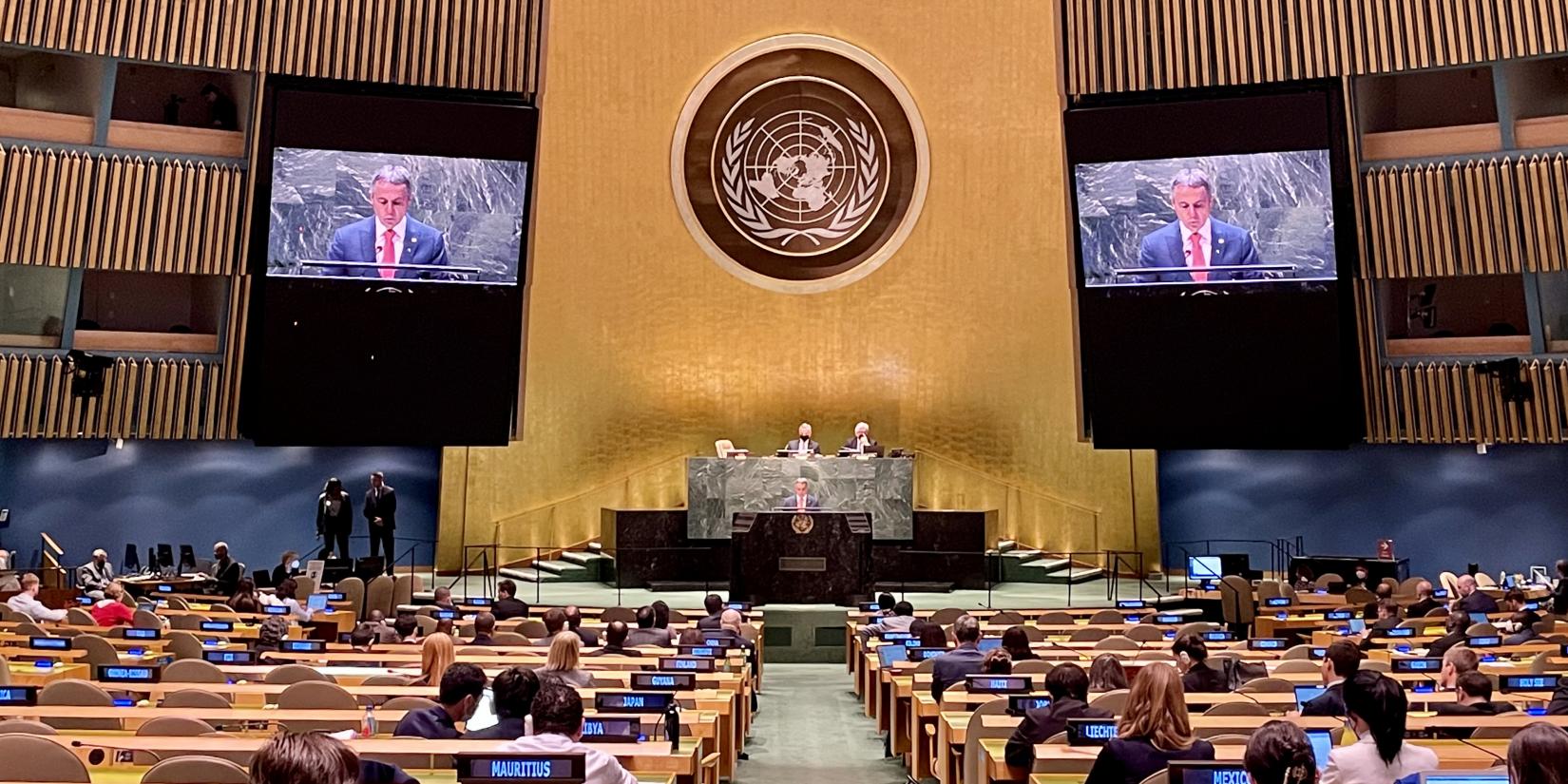The nuclear threat was omnipresent during the Cold War. But it is still real, as developments in context of the Russian military aggression against Ukraine demonstrate. The 1968 Nuclear Non-Proliferation Treaty is the basis for disarmament and non-proliferation of nuclear weapons. At the Treaty Review Conference taking place in New York from 1 to 26 August 2022, President Ignazio Cassis calls for concrete measures in view of slow pace on nuclear disarmament.

The nine nuclear powers, of which the US, Russia, France, China and the United Kingdom are officially recognised, still possess an arsenal of some 13,000 nuclear weapons. This firepower is equivalent to 2,000 times that of all the bombs and shells fired during the Second World War. This could wipe out humanity and destroy the planet many times over. " We all know that any use of nuclear weapons would have catastrophic humanitarian consequences. And all evidence underlines that it is improbable that nuclear weapons could ever be used in accordance with the principles and rules of international humanitarian law," stresses Swiss President Ignazio Cassis.
Disarmament stagnating worldwide
Sixty years ago, the world narrowly missed a nuclear apocalypse. In October 1962, humanity stared spellbound at Cuba, where the Soviet Union began to position nuclear missiles in response to US missiles set-up in Turkey. The nuclear arms race between the USSR and the US intensified and other states began to take an interest in possessing nuclear weapons. Against this background, the Non-Proliferation Treaty (NPT) was concluded in 1968 and entered into force in 1970. This laid the foundation for global nuclear disarmament. To date, 191 states – including the five official nuclear powers – have signed the NPT. The Treaty has three objectives:
1. Non-proliferation: The five official nuclear powers are banned from transferring nuclear weapons to other recipients and other parties to the Treaty from developing, producing or acquiring nuclear weapons.
2. Disarmament: Existing nuclear arsenals are to be disarmed.
3. Peaceful use: All parties to the Treaty have the right to use nuclear energy for peaceful purposes.

Today we are a far way from the peak of the 1970s, when 70,000 nuclear weapons could have been fired at any time from missile silos or submarines. Yet nuclear disarmament has stagnated for several years now. Thousands of nuclear weapons are still ready for use at the push of a button. And the production of nuclear weapons is increasing. Russia’s military aggression in Ukraine and its threats of nuclear weapons further complicate negotiations on nuclear disarmament.
Ignazio Cassis calls for concrete measures in New York
Every five years, the NPT States parties review the implementation of the Treaty and compliance with it under the watchful eye of the International Atomic Energy Agency (IAEA). Between 1 and 26 August 2022, they will meet in New York for the Review Conference, which had to be postponed several ties because of COVID-19. Expectations for the Conference are high. Switzerland is offering to act as a bridge-builder to find compromises.
"We must reduce the role of nuclear weapons, reduce the likelihood of a nuclear accident or usage as a result of a misunderstanding. Words must be complemented by concrete action to avert humanitarian and environmental disasters," said President Cassis in his video message at the opening of the Conference.
Implementation of the Nuclear Non-Proliferation Treaty means security for Switzerland
At the Conference, Switzerland, which ratified the NPT in 1976, is setting priorities in three areas. First, it advocates practical disarmament measures. In the run-up to the Conference, it made numerous concrete proposals to reduce the risks posed by nuclear weapons. Secondly, it proposes a strengthening of the global non-proliferation norm, for example through reviews by the International Atomic Energy Agency (IAEA). Thirdly, the peaceful use of nuclear energy should remain guaranteed under strict safety conditions.
Switzerland is committed to ensuring nuclear safety for the global community and thus also for Switzerland. Peace and security are priorities of Switzerland's 2020–23 Foreign Policy Strategy, so nuclear disarmament and the prevention of nuclear proliferation are of key importance.
Back to the path of disarmament
The slow pace disarmament shows that the Nuclear Non-Proliferation Treaty has not yet reached its disarmament goal. Against this background, a more far reaching agreement, the Treaty on the Prohibition of Nuclear Weapons, entered into force in January 2021. Switzerland has not yet signed this treaty because there are questions about the efficiency of this new treaty and its interplay with the NPT. The outcome of the current Review Conference is an important aspect in the re-evaluation of Switzerland's position on the Treaty on the Prohibition of Nuclear Weapons. Switzerland wants to help form a constructive relationship between the Nuclear Non-Proliferation Treaty and the Treaty on the Prohibition of Nuclear Weapons, because the goal of these two treaties is the same: a world without nuclear weapons.
"We need to get away from nuclear build-up and parading nuclear arsenals - back to the path of arms control and disarmament," said Ignazio Cassis in New York; the risk of a nuclear catastrophe will remain until the last nuclear weapon is dismantled.
Nuclear powers on the UN Security Council
The five permanent members of the UN Security Council are also the five official nuclear powers. As a non-permanent member of the Security Council in 2023-2024, Switzerland has the opportunity to use this position to foster dialogue and to emphasise the Swiss position on disarmament and the non-proliferation of nuclear weapons.




